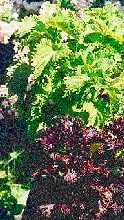View crop
View crop Data sheet EcoPortPerilla frutescens
 |
|
| Notes |
|---|
| DESCRIPTION: It is an erect, annual herb that grows 0.3 to 2 m tall. The villose stems are purple or green with four parallel grooves. Opposite leaves are membranous or herbaceous, broadly ovate or orbicular, 7-13 cm long and 4.5-10 cm wide, with mucronate tips, a rounded or broad cuneate bases, and dentate margins. The pilose surface of the leaves may be green or purple on both sides, or purple on the underside only. Each leaf has seven to eight pairs of lateral veins, which are closer together near the base. The veins on the upper surface are slightly raised, significantly so on the underside. The petiole is flat and villose. Composed of a pair of flowers, the villose corymb inflorescence may grow terminally or from the leaf axil. The ten-veined, campanulate calyx is villous basally outside and yellow glandular dotted on the surface, and pilose near the inside base, arranged in a ring. The calyx is initially about 3 mm long, but expands to 1.1 cm, spreading or drooping and swollen at the base when fruited. The labiate calyx has a broad upper sepal that is three-lobed and slightly longer than the lower sepal, which has two lanceolate lobes. The corolla is campanulate, white to magenta, 3-4 mm long, glabrous, and slightly pilose outside but less so inside. The limb of the corolla is also labiate, and composed of a slightly lobed upper petal and three-lobed lower petal. The sub-globose fruits are reticulate nutlets, grayish brown, about 1.5 mm in diameter. In China, flowers and fruits appear in August and linger until November to December. USES: It is widely cultivated as a source of medicine and spices. Perilla oil, a drying oil, which is contained in the seed, is edible (a cooking oil) and also used as a preservative and energy source. It is used in making paints, varnishes, water proofing etc. The seeds of perilla contain 31 to 51% of this drying oil, which is similar to tung or linseed oil. The plant yields 0.3-1.3% essential oil, which contains 20% citral. It is also used in dental products. One of the aldehyde isomers found in Perilla is 2,000 times as sweet as sugar. HABITAT: It is found wild in pastures and fields, dry woods, along roadsides, about home-sites, and in waste places. ENVIRONMENT: It needs warm weather and can grow in full sun as well as light (not dark) shade. However, the seed needs light to sprout. It thrives in well drained as well as wet soils. It grows well on fertile sites. It is hardy to zone 8 and is frost tender. It prefers light (sandy) and medium (loamy) acid, neutral and basic (alkaline) soils. COMMON NAMES: It is widely known as the beefsteak plant. In North America, it is increasingly commonly called by its Japanese name, shiso in addition to being generally referred to as perilla. FURTHER INF.: The economic return from production of perilla as an oilseed in the United States is unprofitable in comparison with linseed. It has been determined that although perilla is well adapted to the climate of the south eastern United States, it will be unprofitable unless seed shattering can be controlled. | Sources |
| Janick J. Simon J.E. (eds.), New crops. Wiley, New York. [TEXT] http://www.invasive.org/weeds [DESC] Plants for a Future [USE] Wikipedia [TEXT] |